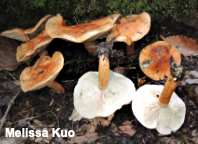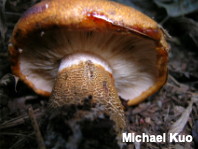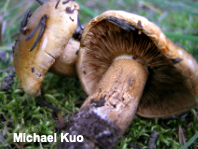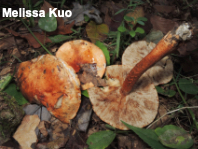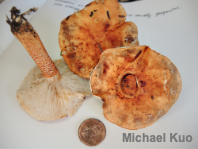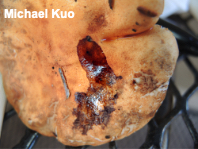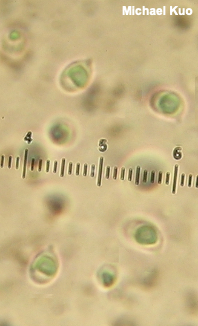| Major Groups > Gilled Mushrooms > Pale-Spored > Tricholoma > Tricholoma aurantium |

|
Tricholoma aurantium [ Basidiomycota > Agaricales > Tricholomataceae > Tricholoma . . . ] by Michael Kuo This gorgeous Tricholoma is easily recognized by its sticky orange cap; its mealy taste; and its distinctive stem, which features scaly orange girdles that terminate near the apex, leaving a white zone at the top and creating a sheathed appearance. However, Tricholoma aurantium has no partial veil, and the sheathed appearance results from the arrangement of the tiny scales rather than a true ring. Tricholoma aurantium is mycorrhizal with various conifers and can be found throughout much of northern and montane North America; in fact, according to a recent DNA study (Heilmann-Clausen and collaborators, 2017), its distribution is circumboreal. I am enough of a mushroom dork to have been thrilled when I discovered (while studying the "Material Cited" sections of Ovrebo's 1980 dissertation on Tricholoma—I told you I was a dork) that one of my collections of this mushroom was made in the same location as collections made by prominent mycologists over the years, including Robert Shaffer in 1968 and Nancy Weber in 1974. The Carp Creek Gorge in Cheboygan County, Michigan, is a beautiful location, and Tricholoma aurantium appears to have set up permanent residence under the stately pines found there. Description: Ecology: Mycorrhizal with conifers; growing scattered or gregariously, sometimes in clusters; fairly widely distributed in northern and montane North America (including the Rocky Mountains and the Appalachians); summer and fall. The illustrated and described collections are from Colorado, Michigan, and Kentucky. Cap: 4–9 cm; convex when young, expanding to broadly convex or nearly flat; slimy or sticky when fresh and young; orange to dull reddish orange, bruising red; fading to dirty brownish orange and often developing a fine mosaic of broken-up pigmentation; fairly bald, or with scattered, appressed fibrils and, in age, scales; the margin initially inrolled and, when fresh, adorned with droplets of red liquid. Gills: Broadly attached to the stem, or atached by a notch; crowded; short-gills frequent; creamy, developing brown to reddish brown discolorations; eventually brownish overall. Stem: 3–9 cm long; 1–2 cm thick; more or less equal, or tapering to the base; covered with dense, orange to brownish orange scaly girdles that terminate in an abrupt line near the apex; white above; basal mycelium white. Flesh: White; not changing on exposure, or turning pinkish in places. Odor and Taste: Strongly mealy. Chemical Reactions: KOH red on cap surface. Spore Print: White. Microscopic Features: Spores 3.5–5 x 2.5–3.5 µm; ellipsoid; smooth; hyaline and uniguttulate in KOH; inamyloid. Basidia 4-sterigmate. Cheilocystidia not found. Pleurocystidia not found. Lamellar trama parallel. Pileipellis an ixocutis; elements 2.5–5 µm wide, smooth, hyaline to orangish or orangish yellow in KOH. Clamp connections not found. REFERENCES: (Schaeffer, 1774) Ricken, 1915. (Quélet, 1886; Saccardo, 1887; Kauffman, 1918; Smith, Smith & Weber, 1979; Ovrebo, 1980; Arora, 1986; Phillips, 1991/2005; Lincoff, 1992; Barron, 1999; Roody, 2003; McNeil, 2006; Kuo & Methven, 2010; Bessette et al., 2013; Christensen & Heilmann-Clausen, 2013; Kuo & Methven, 2014; Siegel & Schwarz, 2016; Baroni, 2017; Heilmann-Clausen et al., 2017; Elliott & Stephenson, 2018.) Herb. Kuo 09120409, 09150714, 08140802, 10041511. This site contains no information about the edibility or toxicity of mushrooms. |
© MushroomExpert.Com |
|
Cite this page as: Kuo, M. (2018, November). Tricholoma aurantium. Retrieved from the MushroomExpert.Com Web site: http://www.mushroomexpert.com/tricholoma_aurantium.html |
